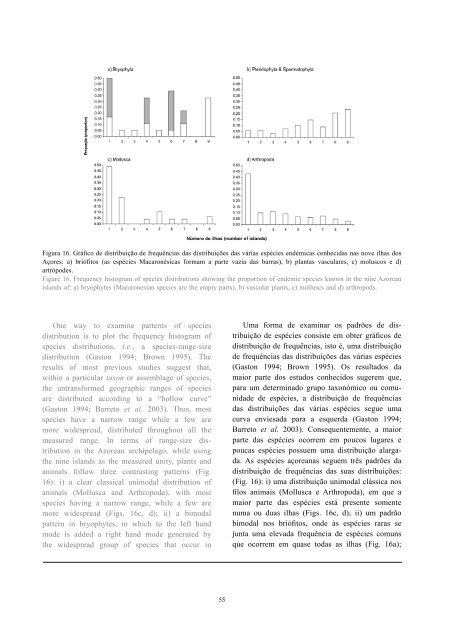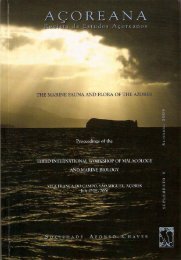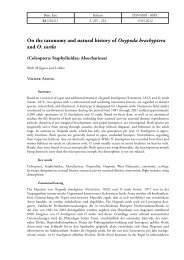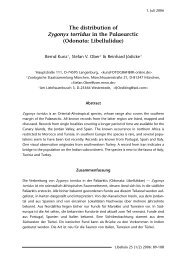(eds.) (2005). - Portal da Biodiversidade dos Açores - Universidade ...
(eds.) (2005). - Portal da Biodiversidade dos Açores - Universidade ...
(eds.) (2005). - Portal da Biodiversidade dos Açores - Universidade ...
You also want an ePaper? Increase the reach of your titles
YUMPU automatically turns print PDFs into web optimized ePapers that Google loves.
Figura 16. Gráfico de distribuição de frequências <strong>da</strong>s distribuições <strong>da</strong>s várias espécies endémicas conheci<strong>da</strong>s nas nove ilhas <strong>dos</strong><br />
<strong>Açores</strong>: a) briófitos (as espécies Macaronésicas formam a parte vazia <strong>da</strong>s barras), b) plantas vasculares, c) moluscos e d)<br />
artrópodes.<br />
Figure 16. Frequency histogram of species distributions showing the proportion of endemic species known in the nine Azorean<br />
islands of: a) bryophytes (Macaronesian species are the empty parts), b) vascular plants, c) molluscs and d) arthropods.<br />
One way to examine patterns of species<br />
distribution is to plot the frequency histogram of<br />
species distributions, i.e., a species-range-size<br />
distribution (Gaston 1994; Brown 1995). The<br />
results of most previous studies suggest that,<br />
within a particular taxon or assemblage of species,<br />
the untransformed geographic ranges of species<br />
are distributed according to a “hollow curve”<br />
(Gaston 1994; Barreto et al. 2003). Thus, most<br />
species have a narrow range while a few are<br />
more widespread, distributed throughout all the<br />
measured range. In terms of range-size distribution<br />
in the Azorean archipelago, while using<br />
the nine islands as the measured unity, plants and<br />
animals follow three contrasting patterns (Fig.<br />
16): i) a clear classical unimo<strong>da</strong>l distribution of<br />
animals (Mollusca and Arthropo<strong>da</strong>), with most<br />
species having a narrow range, while a few are<br />
more widespread (Figs. 16c, d); ii) a bimo<strong>da</strong>l<br />
pattern in bryophytes, in which to the left hand<br />
mode is added a right hand mode generated by<br />
the widespread group of species that occur in<br />
55<br />
Uma forma de examinar os padrões de distribuição<br />
de espécies consiste em obter gráficos de<br />
distribuição de frequências, isto é, uma distribuição<br />
de frequências <strong>da</strong>s distribuições <strong>da</strong>s várias espécies<br />
(Gaston 1994; Brown 1995). Os resulta<strong>dos</strong> <strong>da</strong><br />
maior parte <strong>dos</strong> estu<strong>dos</strong> conheci<strong>dos</strong> sugerem que,<br />
para um determinado grupo taxonómico ou comuni<strong>da</strong>de<br />
de espécies, a distribuição de frequências<br />
<strong>da</strong>s distribuições <strong>da</strong>s várias espécies segue uma<br />
curva enviesa<strong>da</strong> para a esquer<strong>da</strong> (Gaston 1994;<br />
Barreto et al. 2003). Consequentemente, a maior<br />
parte <strong>da</strong>s espécies ocorrem em poucos lugares e<br />
poucas espécies possuem uma distribuição alarga<strong>da</strong>.<br />
As espécies açoreanas seguem três padrões <strong>da</strong><br />
distribuição de frequências <strong>da</strong>s suas distribuições:<br />
(Fig. 16): i) uma distribuição unimo<strong>da</strong>l clássica nos<br />
filos animais (Mollusca e Arthropo<strong>da</strong>), em que a<br />
maior parte <strong>da</strong>s espécies está presente somente<br />
numa ou duas ilhas (Figs. 16c, d); ii) um padrão<br />
bimo<strong>da</strong>l nos briófitos, onde às espécies raras se<br />
junta uma eleva<strong>da</strong> frequência de espécies comuns<br />
que ocorrem em quase to<strong>da</strong>s as ilhas (Fig. 16a);

















